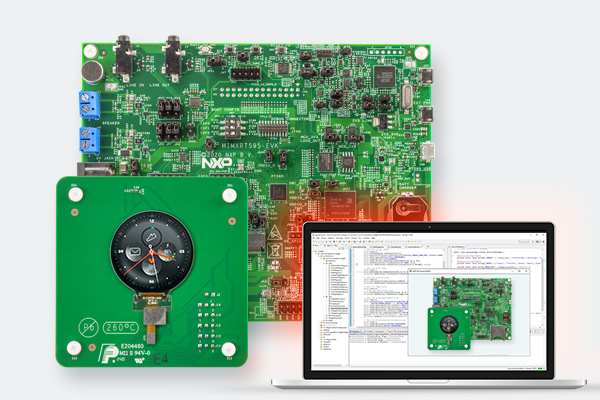Attention Java and Android developers!
With the release of our MICROEJ SDK 6.0, you can now create software applications within your preferred integrated development environments (IDEs) such as Android Studio, IntelliJ or Eclipse.
This is a significant milestone for embedded development and for MicroEJ, one of the few embedded software companies that enables developers to write applications using high-level IDEs such as Android Studio and IntelliJ.
“With this groundbreaking release, MicroEJ takes the lead and places Android compatibility at the forefront,” says Frederic Riviere, our CTO Office Member & VP of Product. “Not only can Android and Java developers now create software applications within their preferred IDE such as Android Studio, IntelliJ and Eclipse, but they can also leverage the robust continuous delivery capabilities offered by the Gradle Build System. This highly anticipated enhancement is pivotal in promoting the adoption of higher-level languages and agile development methodologies in the embedded domain.”
Let’s dive into the highlights of MICROEJ SDK v6 and understand how these new functionalities benefit all developers and IoT device manufacturers:
Enhanced Development Experience with Multiple Supported IDEs
MICROEJ SDK v6 empowers developers with a spectrum of IDEs, ideally suited for Android and Java developers focused on crafting applications for efficient, low-power microcontrollers and embedded microprocessors. This release underscores MicroEJ’s commitment to democratize modern development tools for the embedded domain, aligning with the preferences of the Java development community’s top three IDE choices and the Android community’s preferred IDE.

source: JetBrains
MICROEJ SDK v6 provides support for the following IDEs, with more to be announced soon:
- IntelliJ IDEA by JetBrains: Renowned as the premier IDE for software developers, IntelliJ IDEA boasts a rich set of features, such as autocompletion, code refactoring, and intelligent suggestions. These capabilities enhance the productivity and enjoyment of Java and Kotlin development.
- Android Studio: The preferred choice for Android developers, Android Studio provides a robust environment for creating embedded applications. MICROEJ SDK seamlessly integrates with Android Studio through MicroEJ’s Android Compatibility Kit. This integration empowers dual development and ambient modes, optimizing power consumption and resource utilization.
- Eclipse: As the second most popular IDE for Java development, Eclipse stands out for being open source, user-friendly, and supporting multiple programming languages such as C, C++, and Java. We are committed to supporting Eclipse for developers who prefer this versatile development environment.

Gradle Build System Integration
In previous iterations, MICROEJ SDK was constructed using the MicroEJ Module Manager (MMM), a customized version of Apache Ant and Ivy Projects, and then bundled into an all-in-one IDE based on Eclipse. However, as technology advances, we have made substantial changes to stay current with industry standards.
With MICROEJ SDK v6, we embraced the widely adopted Gradle build automation tool. Gradle is a staple in the software development community, employed by countless developers for building, testing and deploying their projects. Gradle plays a central role in the Continuous Delivery processes of renowned companies such as LinkedIn and Netflix. Furthermore, Gradle is the modern build system of choice for Java developers and is seamlessly integrated into popular IDEs such as IntelliJ and Android Studio.
Benefits of Gradle Build System:
- Flexibility: Gradle’s flexible and extensible build system allows developers to tailor their build processes to meet specific requirements.
- Java Integration: With a strong presence in Java projects, Gradle seamlessly aligns with MicroEJ development, ensuring a natural fit.
- Build System for Android: As the primary build system for Android, Gradle guarantees familiarity and compatibility for Android developers.
- Thriving Community: A vast and vibrant community of developers and resources stands ready to support your projects.
- Abundant Plugins: Extensive plugin support facilitates seamless integration with all major IDEs, including IntelliJ, Android Studio, VSCode, and Eclipse.
- Performance Optimization: Gradle features incremental builds, determining whether a task needs execution. This ultimately saves valuable time during the build process.

In addition to being based on Gradle now instead of MMM, MICROEJ SDK v 6 is no longer dependent on Eclipse, offering more freedom in choosing your IDE. The SDK is also now available in an online repository for easy integration into your projects and gets continuously updated.
What about MICROEJ SDK v5?
We recommend that every new application project begins with MICROEJ SDK v6. MICROEJ SDK v5, however, will continue to receive support, but all new features will be introduced in SDK v6:
- MICROEJ SDK v5 in Maintenance Mode: All new features and developments will be focused on MICROEJ SDK v6.
- Two-way Compatibility: MICROEJ SDK v6 can import modules produced by SDK v4 (Ivy) and SDK v5 (MMM), ensuring a smooth transition for existing projects. Similarly, MICROEJ SDK v5 can import modules produced with v6.
- MICROEJ SDK v5 for VEE Port: MICROEJ SDK V5 remains the SDK of choice for VEE PORT until we bring the VEE PORT tooling to MICROEJ SDK v6, which is expected to occur in the first half of 2024.
Before using the SDK, you must accept the MicroEJ License under the MICROEJ SDK End User License Agreement (EULA). This is a permissive license for free evaluation, development and demonstrations, but should not be used for production. Production use requires a paid contract with MicroEJ.





